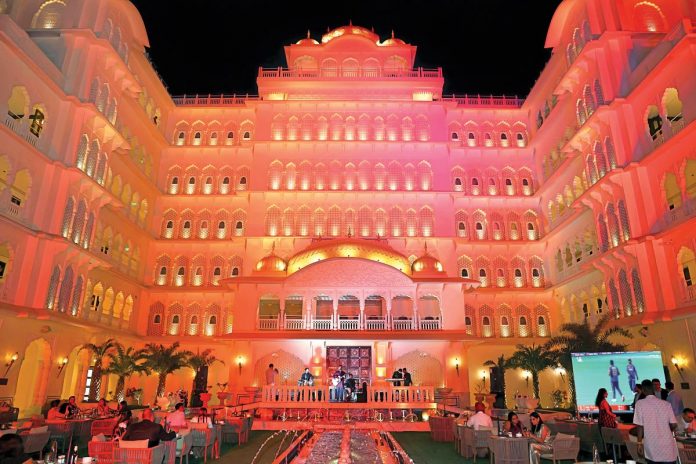As India’s wedding industry transforms at breakneck speed, planners face cascade of fresh challenges. Industry experts convene to decode the chaos at Travel Wedding Show, sharing strategies to redefine the rulebook.
By Janice Alyosius
India’s wedding industry, one of the fastest-growing and most dynamic sectors, demands seamless collaboration between planners, hotels, airlines and tourism boards to create unforgettable experiences. The Travel Wedding Show at Anantara Jewel Bagh Jaipur took a bold step in this direction by hosting a focused, high-impact event—bringing together the country’s top wedding planners and key industry players, where they discussed the challenges and proposed resolutions to tackle them.
What made this show truly unique was its streamlined approach; no small suppliers were involved, allowing wedding planners to engage directly with hotels, airlines, national tourism boards and insurance companies in structured 10-minute meetings. This setup enabled meaningful conversations without the usual clutter.
In just two days, participants accomplished what might typically take six to eight months of meetings—accelerating potential partnerships, while ensuring that regular business operations remained disruption free.
By fostering such focused collaboration, the Travel Wedding Show underscored the growing importance of synergy amid the stakeholders of India’s wedding industry and has set a new benchmark for how business can be done efficiently and effectively.
Wedding planners
With the evolving dynamics of wedding industry in India, stakeholders find inflation, demand for visually appealing milieu, quest for pininterest-worthy settings and limited infrastructure as the new set of bottlenecks blocking the road to sectors’ growth.
Escalating wedding costs
Industry experts believe that post-pandemic, the weddings are witnessing heftier price tags due to inflation. With costs climbing across hotel bookings, décor and logistics, both couples and planners are feeling the pinch. “A wedding for up to 200 people that earlier costed ₹2 crore is now closer to ₹3 crore,” said Harsheen Bincymon, Director, Enjay Weddings & Luxury Events. Although he also pointed out that the surge in hotel prices is driven by sheer demand. Agreeing with Bincymon’s claim, Nittin T Dubey, Director, Seven Wonders Vacations, shared, “In Rajasthan, the hotel buyout alone costs ₹3 to ₹4 crore. With décor and entertainment, a luxury wedding easily crosses ₹5 crore for two nights.”
Solution: Value for money
With demand driving up prices, planners are focusing on delivering value so that the customer feels that every rupee is well spent. “Clients are now smarter and more aware. Our job is to help them prioritise and ensure they get value for money. Whether it is a destination or local wedding, we help them consolidate events to keep it efficient,” said Bincymon, asserting that it is the only way forward to resolve the rising issue of inflation.
Reel vs real
Social media platforms such as Instagram and Pinterest have turned wedding planning into a visually driven fantasy—often stretching far beyond what is financially or logistically feasible. “Young couples see weddings on Instagram and want the exact same thing,” said Vandita Bawa, Senior VP, WDNE. “But their parents are paying and they are usually more conservative with spending. This gap creates friction.” Additionally, “too much information can be misleading. Something trending online is often mistaken as the norm”, warned Bincymon.
Solution: Fact-checking fairytales
To bridge the gap between dreamy social feeds and real-world budgets, planners suggest turning to experience-led consultations showcasing real-life case studies. “I always tell my clients—do not go by Instagram alone. Come and see things in person,” said Bawa. “We create a more personal connect by showing real décor, setups and references.” Bincymon emphasised, “We encourage fact-checking and open conversations. It is about building trust through education.”
Inconsistent pricing
Many hotels and venues, especially in emerging destinations, are not fully equipped or trained to handle high-end weddings. Stressing on the challenge, Dubey said, “Some hotels are simply not prepared, especially newer or standalone properties. Pricing fluctuates wildly depending on inventory or demand and there is no standardisation.”
Solution: Consistent rate cards
To resolve pricing issues, wedding planners suggest stronger collaboration across the hospitality industry, starting with standardised pricing and a deeper understanding of wedding-specific requirements. “There should be a standard rate card for at least four to six months for wedding segment,” suggested Dubey.
Limited infrastructure
Planning weddings in offbeat or smaller destinations—domestic or international—brings challenges in connectivity, infrastructure and access to services such as Indian catering or experienced vendors.
“Planning in Jaisalmer or Jodhpur can be hard with limited flights and few hotel options. Many international destinations such as Spain or Portugal do not have direct connectivity from India,” explained Amit Hooda, Founder, The Wedding Connections.
Solution: Advance planning
Planners are working around these gaps by mapping destination suitability based on weather, guest count and logistics. They are also lobbying for support from tourism boards. “We help clients choose destinations based on accessibility and local support,” said Hooda. “If they help with smoother visas and paperwork, we could plan more global weddings. In the UAE, Indian catering is easily available, but in Europe, we have to fly in chefs—adding huge costs. We suggest options that meet dreams as well as practicalities,” he added.
Accessing global destinations
While global weddings remain aspirational, many families are now opting for domestic destinations due to government policy shifts, tax scrutiny and currency limitations. “With the PM’s push to hold more weddings in India and increased focus on white money, families are preferring to stay within India without any complications,” stressed Bawa.
Solution: Rise of Desi Destination
Planners are adapting by bringing the international wedding experience to Indian venues, paying more heed to smaller towns. “Even if it is a local wedding, people prefer doing it in a two-day destination style to maximise time and minimise hassle. The intent is to be under one roof and stress-free” said Bincymon.
Demand for entertainment
Entertainment is central to Indian weddings but sourcing quality performers, tech riders and managing logistics can be time-consuming and expensive affair for the planners. Highlighting this challenge, he said, “Entertainment—from anchors to musical pheras—is non-negotiable. Around 25 to 35 per cent of the budget goes to this.”
Solution: Quality performers
To deliver top-notch quality entertainment, planners are investing in top-tier production to delight guests. “Each event, sangeet or mehendi, demands its own unique vibe,” emphasised Hooda, suggesting, “So we bring in performers who can transform the milieu.”
Influence of Technology
Recognising the ubiquity of AI across sectors, Rachit Jain, Director, Rashi Entertainment, highlighted its inevitable influence on the wedding industry. “The technological innovations happening in weddings will increase the effectiveness of organising them, offering a different experience altogether. Recently, we used QR code invites in one of the weddings, which made it easier for guests to attend it. We even use VR cameras that allow guests to relive the celebration anytime,” he shared.
- With demand driving up prices, planners are focusing on delivering value so that the customer feels that every rupee is well spent
- While international weddings remain aspirational, many families are now opting for domestic destinations
Airlines
As couples embark on the journey to their dream wedding for seamless travelling experience, airlines are coming up with unique ways to resolve pertinent issues related to handling of guests, baggage space and last-minute changes in guest-list.
Rise of wedding charters
What was once a luxury is now almost essential—chartering aircraft for weddings has taken off in a big way, especially for families who want full control of the guest experience from takeoff to landing. “Today, families do not want the hassle of coordinating 40 to 50 individual tickets or worrying about flight delays for guests. They would rather book out an entire aircraft,” shared Dhanashree Nagarkar, Manager India Leisure MICE & Groups, Oman Air.
“We have handled full charter operations where everything—from boarding cards with wedding logos to in-flight meals matching Indian tastes—is customised. We even coordinate with ground teams for special handling at departure and arrival,” Nagarkar added.
The ability to personalise each and every step of the journey has made charters particularly popular for weddings in the Middle East, Thailand and Mauritius, due to relaxed visa rules and manageable flight durations. She shared, “We work closely with wedding planners, tour operators, and even decorators, if needed. We have had families request traditional music during boarding the plane and special seating for the bride and groom.”
Name change flexibility
In In ian weddings, guest lists are notoriously fluid. Oman Air and other airlines are stepping up with generous name change policies in order to accommodate late decisions. “We understand the Indian wedding dynamics—names get confirmed late, there are last-minute swaps, sometimes due to visa issues or family emergencies,” she explained. “That is why we allow name changes free of cost before ticketing and post-ticketing changes come at a nominal fee. We just need a notice of 72 hours and our teams would make it happen,” she added
Enhanced baggage allowances
A single family’s baggage could include wedding attire, jewellery boxes, return gifts and even puja material. That is why the airlines are pre-emptively offering additional baggage allowances and working with the ground teams in a bid to ensure VIP handling. “We have also seen families carry as much as 15 to 20 kilogrammes per guest, which is above the normal limit, and we plan for it much in advance. We also ensure that group check-ins are seamless,” Nagarkar said.
In elaborate Indian weddings, guest lists are notoriously fluid. Oman Air and other airlines are stepping up with generous name change policies in order to accommodate late decisions.
Insurance
Despite spending crores on a dream wedding, many Indian families still skip wedding insurance, leaving them vulnerable to disruptions, cancellations or damage. But a new generation of travel and event insurance providers is working hard to change that.
One event, hundreds of risks
“Weddings are emotionally loaded and financially risky events in a family’s life—but most go uninsured,” said Kunal Choudhary, VP, Sales, Asego, pointing out, “A single vendor default, venue accident or political disruption can cause ₹10–50 lakh losses overnight and yet, because insurance is not at the top of the mind, families only realise it when something goes wrong.”
He recalled a recent case where a multi-crore destination wedding was nearly cancelled due to floods—but had no backup plan. “They had invested in décor, hotel rooms, logistics—everything was ready—but did not insure the event. They lost close to `1.2 crore. Insurance would have costed them just ₹1.5 to 2 lakh,” he explained.
Insurance tailored for weddings
Asego and similar providers are building customised plans as per Indian wedding dynamics—from gold theft to event cancellations or flight disruptions. “We do not offer cookie-cutter solutions. Every wedding is different. If the focus is on jewellery, we cover that. If it is travel or weather risk, we tailor the premium accordingly,” said Choudhary.
Last-minute booking
Families often think it is too late to insure once vendors are booked or guests are flying in. That is not true, as per Choudhary, he informed, “We can activate a policy as close as seven days before the event.” While early planning is ideal, last-minute requests are not a dealbreaker. “We do not turn anyone away just because they are in a crunch,” he added, while asserting, “The more high-profile the wedding—global locations, high-value jewellery—the more critical it is to get insured quickly.”
Asego and similar providers are building customised insurance plans as per Indian wedding dynamics
National Tourism Offices
National Tourism Offices are going beyond promotional events and activities. Instead, they are rolling up their sleeves to prepare local ecosystems, serving Indian cultural needs and offering incentives to planners and guests alike.
Incentives for planners
Thailand, a long-time favourite for Indian weddings, is actively wooing planners and guests. “We currently offer `800 per guest for weddings above 150 passenger,” said Pinki Arora, Marketing Representative, Tourism Authority of Thailand (TAT), adding, “We also reimburse tickets for planners and have earlier offered spa vouchers or welcome dances such as Thai classical shows. It is our way of making them feel valued.”
Cultural training
Thai service providers are being trained to understand Indian customs. “Indians eat lunch later, prefer vegetarian menus and expect personalised service,” Arora noted. “Before promoting a destination, we run tourism clinics to educate local vendors. This includes chefs, drivers, florists—everyone involved. It makes the experience smoother and more authentic,” she added.
As Indian weddings scale new heights of grandeur, so do the stakes. From soaring costs to shifting guest lists, planners now juggle logistics with emotions—teaming up with airlines, insurers and tourism boards. Together, this ecosystem is redefining how modern Indian weddings are planned, priced and protected—blending opulence with operational precision.
“We currently offer ₹800 per guest for weddings above 150 passenger.” – Pinki Arora, Marketing Representative, Tourism Authority of Thailand (TAT)















